Thomas E. Ricks's Blog, page 188
April 25, 2012
Annals of command and control: Air Force Africa stands down, disappears
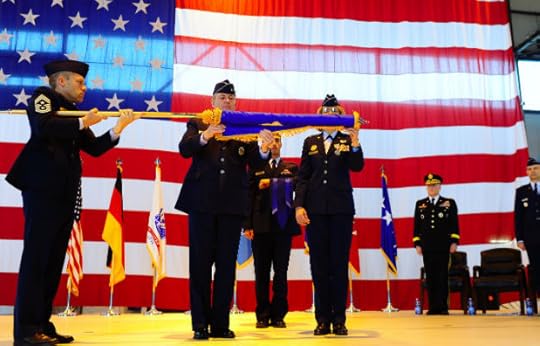
Remember how I found command
and control for the Libyan situation kind of confusing? Apparently so did
others.
The Air Force is now folding the 17th
Air Force, the designated unit for African operations. Their jobs are being
tossed back to Air Force Europe, which had to do the first combat mission that
came along for Air Force Africa anyways.
(HT to JT)
April 24, 2012
What exactly did Tom say about military education at last week's FPRI hoedown?

Here's my prepared text from the
FPRI discussion of professional military education (PME) last week. This
isn't exactly what I said, but is pretty close. If you listen
to the audio you'll hear I also riffed a bit, but this is close enough.
Despite what you may have heard, I am not an opponent of
PME. I am a big fan of it -- or at least of good
PME.
I have read enough history to be persuaded that the key
ingredient in officership in the interwar period was a good, rigorous
educational system, with grades and class rankings. At the end of World War II,
one German general (Von Rundstedt) said in 1945, "We cannot understand the
difference in your leadership in the last war and in this. We could understand
it if you had produced one superior corps commander, but now we find all of
your corps commanders good and of equal superiority." The reason seems to have
been the quality of professional education Army officers received in the 1920s
and 1930s.
I agree entirely with Professor
Johnson-Freese: She nails it. The problem is lack of rigor, precision, challenge. The faculties are too often weak and superficial. The leadership too
often is unknowledgeable. The
students do not learn how to think
critically.
But you know what? It is not my problem. It is the problem
of the PME establishment.
By that, I mean that I don't have to do anything. The
federal government's budget crunch is going to take care of much of this. I
suspect that in the coming decade, any institution, department, or individual that
cannot demonstrate a clear, positive contribution is going to get axed. Rather,
my concern is that the baby will be thrown out with the bathwater. There is a
lot of good in military education, but if you let the bad persist, it will drag
down the rest. So if you value the good being done, you will be vigilant in
policing the lazy, the stupid, the careless, the slacker colleges. And many of
us know who those are.
One quibble: I do wonder if the war colleges, staff colleges
and academies are fulfilling their role as internal critics of the institution.
I have not seen a critique of Army leadership, for example, any where as near
as incisive at the Army War College's 1970 study on professionalism. Has the
track record been perfect over the last decade? Looking at Tora Bora, Abu
Ghraib, Black
Hearts -- I don't think so. Isn't it time for such a review-how did we do
over the last 10 years, what worked, what didn't? Where is the introspection
that would be a sign of a healthy intellectual climate?
Back when it was not uncommon to lose every officer in a battalion in a battle

I've been reading Six
Weeks: The Short and Gallant Life of the British Officer in the First World War,
by John Lewis-Stempel. I bought it in a store in St. Ives, Cornwall, on a
stormy day when the tops of the gray waves off the Irish Sea were hitting the
slate roofs of waterfront houses in the town. (But in Doc Martin,
wasn't Cornwall always sunny?)
One thing that has really struck me in the book is how often
battalions would lose many or even all their officers in a battle. "I ended up
the only officer in the battalion," wrote 2nd Lt. Stuart
Cloete, who was 19 years old. Of the 30 officers in one battalion of the
East Surry Regiment who went into a battle on the Somme, four came back. And the 6th Battalion of the
King's Own Scottish Borderers lost every one of its 20 officers in an attack on
September 25, 1915. If I recall correctly, Robert Graves wrote in Good-bye to All That that as a
lieutenant he went on leave and returned to find himself the senior surviving
officer in his battalion.
I also was struck by the narrowness of military history in
the small bookstores I visited in Cornwall. Basically, they are about the
British in the two world wars, with a soupcon of the Falklands and Iraq tossed
in. I can understand not paying much attention to the Americans, but how about
ancient history at least?
And has anyone read Emperor Maurice's Strategikon?
Worth reading?
Not so fast, Lt. Col. Cooper! First, let's discuss the value of right sort of airpower to support national security strategy

By Liesl Carter
Best Defense guest respondent
Over the past week, there have been three articles on Best Defense discussing Air Force Total
Force. As a colleague of Luke
Ahmann and someone who has sat across the table from Mr. Al
Robbert from RAND, I am inclined to focus my comments on their discourse,
but the latest article in this series, by Lt.
Col Tom Cooper, makes an important point about airpower and how the current
tit-for-tat cost comparison debate detracts from the critical need to focus our
efforts on what is the right air component our nation. Lt. Gen Charles Stenner echoed these
sentiments when he said, "I am done with dueling costs." So, I agree cost
comparisons are only as strong as the assumptions they are founded on and do
not advance the question of "What is right for our nation's defense?"
During the past decade, the strength
of our total air force has been tested and has proven to be exceptional. The active and reserve components are equally
ready and capable of meeting the operational airpower requirements of the
combatant commanders. And I agree with
Lt Col Cooper that "the Air Force embraced the reserve component as a cheaper
way of ensuring capacity was available for the nation to provide airpower." This statement recognizes that the airpower
discussion cannot be divorced from a force structure decision. While Lt Col Cooper would like the cost
discussion to disappear, a critical conversation about the force structure
needed to provide airpower is imperative.
If cost is set aside, then what are the right principles
that should guide the proper mix of active and reserve components? Lt Col Cooper's point -- that the required
airpower needs to support national strategy -- is the key. This strategy requires the air force to
maintain a certain capability and capacity to meet a future spectrum of
conflicts. The service also needs to
ensure these forces are accessible. While these factors of capacity, capability, and accessibility have
associated costs, there are other intangible factors that should also be part
of any force structure equation. These
include the effects of force structure decisions on the civilian-military gap
and the retention of human capital. With
these five principles (capacity, capability, accessibility, civilian-military
relations, and retention of human capital) in mind, what force structure best
supports the airpower required for our nation's defense?
The new Strategic Defense Guidance states the military will
be able to "deter and defeat aggression by any potential adversary" and that we
will be able to "project power despite anti-access area denial challenges." The
military will do this by protecting "its
ability to regenerate capabilities that might be needed to meet future, unforeseen demands, maintaining
intellectual capital and rank structure that could be called upon to expand key
elements of the force," and embracing the concept of reversibility. These national strategic priorities drive a
force structure that maintains the most capability (e.g. modernized A2AD
weapons and niche skills) and most capacity (airmen and equipment)
available. It also requires the maximum
retention of human capital possible, so as not to lose the operational
experience gained over the past decade.
Cutting the reserve component is not the solution. By keeping a larger proportion of force
structure in the reserve component, the Air Force supports the national
priorities, embraces the concept of regeneration and reversibility, and
maintains the highest level of experience and rank necessary to meet an unknown
future. While cost comparisons, such as
the RAND study, are interesting, they are a small piece in a much larger
puzzle, and neglect the concept of value. The whole picture must consider what airpower capability and capacity is
required to support the strategic guidance while maximizing the intangible
value of the force. A move towards
maintaining a larger proportion of the total air force in the reserve component
is what will provide the best airpower for our nation's defense.
(Note:
Interview conducted with Lt. Gen Charles E. Stenner on February 22, 2012)
Liesl Carter is
currently a national security fellow at the Harvard Kennedy School. She has
served in both active and reserve components of the U.S. Air Force, and is an
airline pilot in her civilian role. She holds a B.S. from the U.S. Air Force
Academy and an M.A. from George Washington University.
April 23, 2012
From his captivity inside the Beltway, Tom calls for end to All-Volunteer Force

I had an article in yesterday's Washington Post that said that. Basically, I argued that the AVF
has made it too easy to go to war and that we should re-connect the U.S.
military to the American people by having a draft. (See Adrian Lewis for more on this.)
--Bill
Arkin says I am "dead wrong." He says I think this way because I am being
held "captive inside the Beltway."
--Spencer
Attackerman says my diagnosis is correct but my remedy would fail. He
doesn't speculate
on whether I am being held, or if so, where.
--Some rightists saw my pro-draft argument as leftist.
But I think Rubber Ducky is right.
Lots of old guys like generals think that a resumption of
the draft is a non-starter. I am not sure that is a view held by the younger
set. Here is a note I got from a smart observer of the military:
I have a bunch of Facebook
friends who are majors and lieutenant colonels. It has been fascinating to me
that about 75 percent of folks at that rank agreed with your op/ed on abolishing the
AVF. Among the Army GOs I think you would be hard pressed to find a single
person who would take that position. One of the LTCs made the point that the
generals hate the Draft era force because they blame it for Army's failings in the
late 60s and early 70s. The bias is that the AVF never would acted in that
manner. The younger guys don't see it that way.
Anyway, I found my very unscientific survey interesting. It does suggest there
might be a pretty big generational gap on a issue where I thought everyone in
the Army agreed. I am not FB friends with enough NCOs to know how they view it.
It suggests there might be
more maneuver room on this issue in the future.
Tom again: Anyway, here is the complete article that ran
in the Post yesterday:
Since
the end of the military draft in 1973, every person joining the U.S. armed
forces has done so because he or she asked to be there. Over the past decade,
this all-volunteer force has been put to the test and has succeeded, fighting
two sustained foreign wars with troops standing up to multiple combat
deployments and extreme
stress.
This
is precisely the reason it is time to get rid of the all-volunteer force. It
has been too successful. Our relatively small and highly adept military has
made it all too easy for our nation to go to war -- and to ignore the
consequences.
The
drawbacks of the all-volunteer force are not military, but political and
ethical. One percent of the nation has carried almost
all the burden of the wars in
Iraq and Afghanistan, while the rest of us essentially went shopping. When the
wars turned sour, we could turn our backs.
A
nation that disregards the consequences of its gravest decisions is operating
in morally hazardous territory. We invaded Iraq recklessly. If we had a draft,
a retired general said to me recently, we probably would not have invaded at all.
If
there had been a draft in 2001, I think we still would have gone to war
in Afghanistan, which was the right thing to do. But I don't think we would
have stayed there much past the middle of 2002 or handled the war so
negligently for years after that.
We
had a draft in the 1960s, of course, and it did not stop President Lyndon
Johnson from getting into a ground war in Vietnam. But the draft sure did
encourage people to pay attention to the war and decide whether they were
willing to support it.
Resuming
conscription is the best way to reconnect the people with the armed services.
Yes, re-establishing a draft, with all its Vietnam-era connotations, would cause
problems for the military, but those could never be as painful and expensive as
fighting an unnecessary war in Iraq for almost nine years. A draft would be
good for our nation and ultimately for our military.
A new edition of Adrian Lewis' terrific study of 'The American Culture of War': The advent of our wars without our people
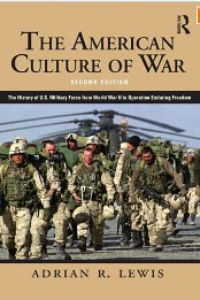
The Best Defense mailbag brings a happy surprise: A new
edition of Adrian Lewis' illuminating history of the modern American
military. I've
blogged about the previous edition, but was quite struck by this sentence
near the end of the new edition: "The
most significant development in the conduct of war in the 20th
century was the elimination of the American people from the conduct of the wars
of the United States."
As is typical of Lewis' terse style, that is a sentence
brimming with meaning that bears re-reading a few times. I suspect he is
correct, I think that this is a bad development, and that we should discuss how
to re-connect the American people to the wars fought in their name.
'The revenge of the Melians' revisited
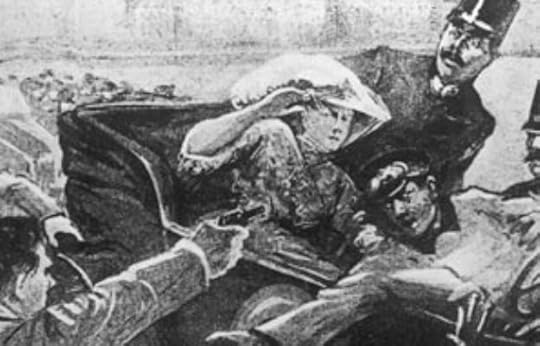
By Ken Weisbrode
Best Defense department
of Thucydidian analysis
Some months after the 9/11 attacks the diplomatic historian Paul
Schroeder published an article in The
National Interest with the title, "The
Risks of Victory: An Historian's Provocation." He posed a simple question
that has been asked many times: How does a minor crisis lead to a major war? He
considered the possibility that the 9/11 attacks would result in something far
worse, and the analogy he gave was to the assassination of Archduke Franz
Ferdinand in 1914.
Another Great War has not taken place, and even if it were to
happen in the near future, it would be difficult at this point to claim that
the fuse for it was lit on September 2001. Much has happened since in Iraq,
Iran, Afghanistan, Libya, Syria, and elsewhere. Nevertheless, Schroeder's provocation
should still be taken seriously. We recall that not once during the entire Cold
War (with the partial exception of Soviet pilots in the Korean War) did
soldiers of the two main protagonists fire on one another. But both superpowers
were engaged in armed conflict to one degree or another during the entire
course of the conflict. The remarkable thing is that none of these smaller wars
or crises escalated to an all-out hot war between the superpowers.
The consensus seems to be that nuclear weapons and the doctrine of
mutually assured destruction are primarily responsible for that. This may be
true but there is no way to prove it. We are told that John F. Kennedy had the
1914 scenario in mind (thanks to his reading of Barbara Tuchman's Guns of August)
during the
Cuban Missile Crisis. The Cold War calculus may have been reversed whereby
nuclear weapons and the prestige associated with deterrence made escalation
more, rather than less, likely in this instance.
A higher cost attributed to escalation, in other words, does not
do away with Schroeder's basic question. How and why do major powers make
crises worse? Political scientists and others have been testing hypotheses for
a long time, but a general blueprint still eludes us. One reason may be that
their models emphasize the roles of major actors over minor ones. For nearly a
century historians have debated whether Germany, Austria-Hungary, Russia or the
"system" was most responsible for the escalation leading to World War I.
Tom has recently reminded us to ask who
won the Peloponnesian War and, by implication, who lost the most after
starting it. Our eyes are trained to hunt for underlying structural conditions,
"the long fuse," and great, zero-sum rivalries.
Overlooked in many of these accounts are the active and sometimes
dominant roles of instigators: Corcyreans, Serbs, Cubans, et al. These second-
and even third-tier revisionist powers tend to follow a different, more
opportunistic calculus. They too -- potentially -- have everything to lose, but also
much more to gain, they must imagine, from provoking a war among much bigger
powers. The burden falls upon the latter to
master the ways of defusing crises before it is too late.
April 20, 2012
General Patton's history of warfare

The other day a friend sent along a
1932 War College paper by Maj. G.S. Patton Jr. on the likely
characteristics of the next war. He actually got that next war wrong,
predicting that small professional forces would prevail over mass armies. Or,
as he puts it, "there is a reasonable probability that the next war will be
characterized by the use of smaller and better trained armies."
Even so, seeing the history of warfare through his eyes is
interesting, in part because they illuminate his approach to World War II, as
when he writes, "Mobility and enthusiasm are a powerful combination."
Here are some of his other observations -- or, rather,
assertions:
--"Distant wars and hard campaigning need quality rather
than quantity." This made me think of Iraq and Afghanistan.
--His summary of the American Civil War: "Up until the
Summer of 1863 a regular force on either side would have had decisive results.
After that date both sides were professional in everything but discipline."
--"The sole useful purpose of depth is to replace losses in
the front line, not to push it on."
--He disagrees with Clausewitz on the tactical importance of
surprise. Patton says that "Surprise is one of the prime requisites to victory.
Broadly speaking, surprise may be utilized in respect to: TIME, PLACE and
METHOD."
Now, anyone wanna argue with Patton about warfare?
April 12, 2012
Another path to airpower: Creating the militia U.S. Air Force of the 21st century
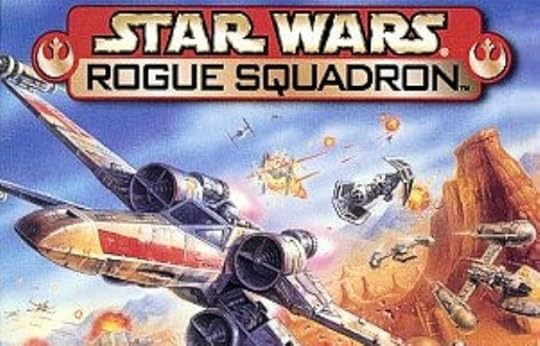
By Luke Ahmann
Best Defense
guest skywalker
The United States Air Force recently
announced its new policy for strategic guidance, given the constrained
resources available: their answer is to trade size for quality. The
current AF is unaffordable. The new AF will be "smaller but superb."1 This sounds good
on paper, but the reality is that a smaller AF may not be able to meet the
surge requirements dictated by unpredictable future threats.
Another solution is to create a more cost
effective AF. Instead of trading size for quality, why not create the most robust, quality AF
that the nation can afford? Why not create a force "capable of deterring and
defeating aggression...in one region even when...committed to a large-scale
operation elsewhere," as defined by the January 2012 Strategic Defense Guidance?2 A return to the militia construct historically founded in our Constitution promises to provide the nation an ability to create such a force.
The Reserve Component (RC) of the AF has
"been transformed, both practically and philosophically, from a strategic force
of last resort to and operational reserve that provides full-spectrum
capability to the nation."3 The RC is an integral
piece of our nation's AF, as we prepare the force of the future, it must be an
integral part of the solution.
The AF will say that a recent RAND study
determined that a full time force is cheaper than a part time force. Really? Cost analysis is only as valid as the assumptions put into them: Change the assumptions, and you change the outcome. Cost studies alone
are typically operating on the margin and lack the macro vision for a true
total force of the future. Absent from the discussion is the long term
value, as well as the ability to "shelf" unneeded surge capability should it be
needed in the future.
The RC provides long term value and an
ability to maintain surge capacity at a fraction of the cost of active
forces. The RC is able to operate and maintain aircraft at 70 percent of the
cost of its active counterparts.4 Recent studies show that RC units cost 25-33 percent less than comparable active units.5 A RC airman
costs, on average, only 38 percent of an active airman.6 The RC can
operate and maintain aircraft AND employ airmen more cost effectively. Creating
a smaller active force, while simultaneously shrinking the portion of the force
in the RC (as currently proposed by the AF), does not take advantage of our nation's militia construct that can provide more capacity for the same cost.
A heavier reliance on the RC does.
The primary arguments against expanding the RC and shrinking the
active forces are that: (1) the RC cannot maintain readiness, and (2) the
RC is not as accessible as the active force. These
are red herrings. Within the AF, the RC is trained and evaluated
to the same standard as active counterparts, yields similar results in
operational inspections, and performs seamlessly in combat. Additionally, the
RC maintains more operational experience in technical fields due to lower
turnover rates. Accessibility of RC is not a structural problem, but a
funding problem. Approximately 70 percent of the RC is part time. In order
to employ them in a full-time status, the AF must pay them. In order to
pay them, the AF must re-allocate a portion of the baseline budget away from
the active force and toward the use of the RC.
The AF has it wrong: It does not have
to trade size for quality. The preceding decade has developed a RC within
the AF fully capable of producing quality air and space power at a reduced
cost. The RC costs less, and therefore, the American taxpayer can protect
the trillions of dollars invested in AF people and equipment by shifting more
toward the RC. Implementing AF proposals to shrink the RC does not take
advantage of the proven cost effective militia construct founded in our nation's heritage. What is best for our nation's AF? An affordable AF
that can execute the mission. Expanding the RC provides such a force.
1. USAF
Force Structure Changes: Sustaining Readiness and Modernizing the Total
Force, February 2012, page 1
2. Sustaining
U.S. Global Leadership: Priorities for 21st Century Defense, January 2012
3. Comprehensive
Review of the Future Role of the Reserve Component, Volume I, 5 April 2011,
page 1
4. FY11
Budget Rollout Brief, http://www.saffm.hq.af.mil/shared/media/document/AFD-100201-054.pdf
5. LtCol
Mark Valentine, Call up the
Reserves
6. FY11
Budget Rollout Brief, http://www.saffm.hq.af.mil/shared/media/document/AFD-100201-054.pdf
Luke Ahmann has served in both active and
reserve components of the US Air Force, most recently as an F-16 Fighter
Squadron Commander. He is currently a national security fellow at the
Harvard Kennedy School. He holds a BS from the United States Air Force
Academy and an MBA from Bentley University.
Thoughts on the V-22 crash in Morocco
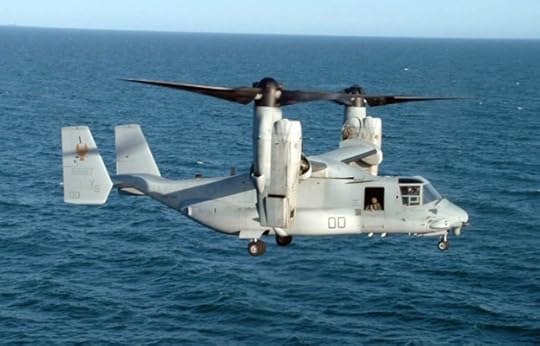
I know the V-22
has posted a
pretty good record, but I keep on thinking of what a Pentagon official once
said to me: No one has ever built a helicopter with jet-engine-like hydraulic
pressures (5,000 ppsi)
inside its nacelles -- and then landed that aircraft in dusty spots where jet
engines fear to go. He said that one little bit of dust inside the nacelle
could weaken the hydraulic tubing, which if it sprang a leak would shoot fluid
so powerfully that it could cut off a man's arm.
When I was a military reporter, this
was the only aircraft I promised my wife I'd never fly in.
Thomas E. Ricks's Blog
- Thomas E. Ricks's profile
- 436 followers



